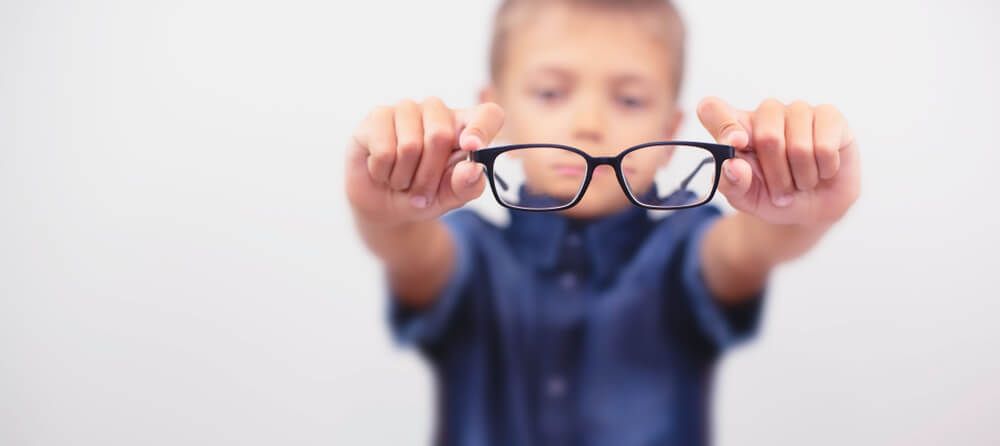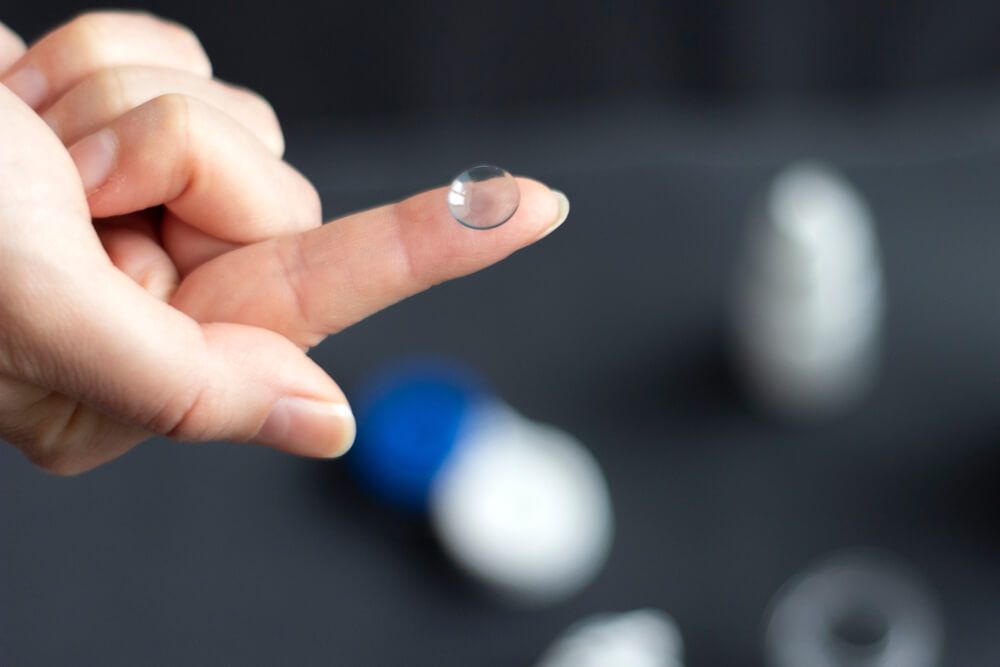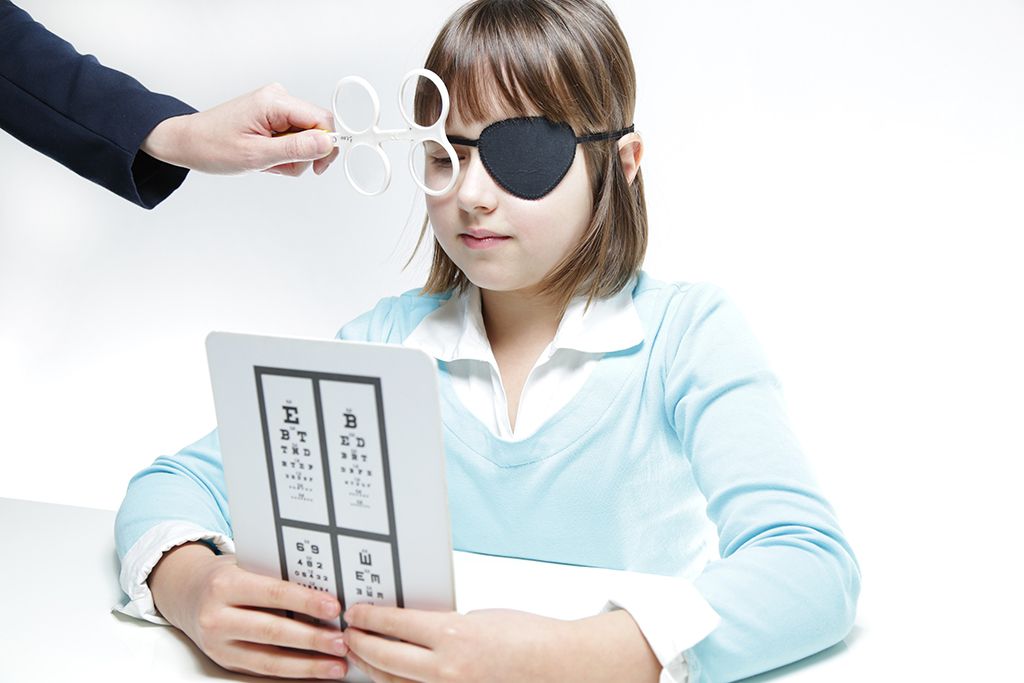
Neurolens are the first and only prescription lenses that include an element of contoured prism in their design. This prism is designed to bring the patient’s eyes into more equal alignment, and this should help to provide relief from the symptoms that are associated with several eye misalignment conditions, including digital eye strain and binocular vision dysfunction.
What is digital eye strain?
Digital eye strain is the name given to describe a group of symptoms that can occur when someone spends long periods of time using digital devices. Since using digital devices requires the eyes to work harder than normal and we don’t always position our devices the perfect distance away, it can lead to issues such as eye pain, dry and irritated eyes, eye fatigue, light sensitivity and blurred vision. Unsurprisingly, the number of people who are experiencing digital eye strain has grown significantly over the last few years and is expected to continue to do so.
What is binocular vision dysfunction?
Binocular vision dysfunction, also known as BVD for short, is another eye condition but is one that is very misunderstood. Binocular vision dysfunction occurs when the eyes aren’t perfectly aligned, causing your brain and eyes to work harder than normal in order to create a clear visual image and remain focused. This places pressure on the trigeminal nerve, which is the nerve that is responsible for the majority of the sensations that we experience in our head and back. BVD can often manifest as other things owing to the huge range of symptoms that are associated with the condition. These can include, but aren’t limited to:
- Blurred vision
- Headaches/migraines
- Double vision
- Motion sickness
- Vertigo
- Dizziness
- Anxiety
Many people don’t think to visit an eye doctor when they are experiencing these symptoms, but all can occur simply because the eyes are out of alignment.
What are Neurolens lenses and how do they help?
As well as containing your usual prescription, Neurolens lenses also contain a specific amount of contoured micro-prism. This micro-prism alters the position of images so that they are aligned in the same plane. This then reduces the pressure on the muscles around the eyes as well as bringing the eyes into alignment, easing the symptoms that the patient has been experiencing.
The amount of prism in Neurolens lenses is decided using the Neurolens eye-tracking device. This non-invasively measures the misalignment that the patient is experiencing, and this is used to form the basis for the patient’s Neurolens prescription. After this, it’s fairly normal for the amount of prism to need to be adjusted by infinitesimal amounts to achieve the optimal relief from your symptoms. Most patients who choose Neurolens treatment see a 50% improvement in their vision as soon as they start to have micro-prism incorporated into their prescription lenses. However, with careful adjustments, many patients see as much as an 80% reduction in the effects of digital eye strain and binocular vision dysfunction.
Want more information about Neurolens? Please contact our knowledgeable eye care specialists.

The parts of a comprehensive eye examination vary according to the patient's age, date of last exam, and other factors. Not all parts of the eye exam may be needed or performed, but the first part of the eye exam will include documenting medical history. Here are some eye and vision tests that are likely to be encountered during a comprehensive eye exam:
Visual Acuity Tests
Visual acuity tests measure the sharpness of vision and are usually performed using a projected eye chart to measure the distance visual acuity and a hand-held small acuity chart to measure the near vision (for reading).
Color Blindness Test
A screening test that checks the color vision is often performed early in a comprehensive eye exam to rule out color blindness.
Cover test to check eye alignment.
A test used to assess strabismus or a more subtle binocular vision problem that could cause eye strain or amblyopia (lazy eye).
Ocular Motility (Eye Movements) Testing
Ocular motility testing is performed to determine how well eyes can follow a moving object and/or quickly move between and accurately fixate on two separate targets.
Stereopsis (Depth Perception) Test
This is used to test perception of depth and 3-dimensional structure obtained on the basis of visual information deriving from two eyes by individuals with normally developed binocular vision.
Retinoscopy
This test is used to estimate which lens powers will best correct distance vision. Based on the way the light reflects from the eye, the doctor is able to obtain an approximation of the eyeglass prescription. This test is useful for children and patients who are unable to accurately answer the doctor's questions.
Manual refraction with a phoropter.
This is the test used to determine the exact eyeglass prescription.

Myopia is a very common issue throughout the world. Approximately 1/3 of the population in the United States have the condition and over 90% of several East Asian countries suffer from myopia. While myopia may seem like such a common condition that it shouldn’t be cause for concern, it is actually associated with several very serious conditions that can threaten one’s ability to see.
What is Myopia
Myopia, more commonly known as nearsightedness, is a condition where individuals are able to see objects that are close to them but may have difficulty distinguishing things at a distance, such as road signs or leaves on a tree. These individuals often squint at objects that are further away to try and help bring them into focus.
Currently, there is no known cure for myopia and recent studies suggest that the more advanced your myopia gets, the more serious the effects can be on your vision. This has led eye professionals to look for ways to slow the progression of myopia in children and young adults as the eyes typically change more rapidly during this time and slowing down myopia progression during these years has a huge payoff.
Types of Myopia Control
There are a few different treatments for myopia that have proven to be effective in a number of studies. Of course, to ensure you find the most effective choice for you, be sure to visit with your eye doctor so they can review your case and recommend the best options for you.
Ortho-K | Ortho-K or Orthokeratology is one practice being used to slow down the progression of myopia. Ortho-K utilizes a special rigid gas-permeable contact lens that is placed into the eyes just before you go to bed. This hard lens helps to gently hold your eye in the proper shape throughout the night. Then when you wake up in the morning and remove the lenses, your eye continues to maintain that shape. This means that people who are nearsighted can see clearly throughout the day, even without wearing contact lenses or glasses. This approach is often preferred for athletes or other active individuals.
Atropine Eye Drops | One of the thoughts about the progression of myopia, is that it is associated with eye strain. The additional stresses that are placed on the eye when straining push the eye further out of its proper shape. Atropine eye drops are specifically designed to help stop the eye from straining and help the muscles relax. Atropine is similar to the eye drops that are used when you get your eyes dilated but lasts throughout the entire day rather than just a few hours. Atropine dilates the pupil of the eye and prevents them from closing too tightly and limiting your vision. This treatment has been shown to be especially effective in slowing the progression of myopia in children.
Multifocal Eyeglasses and Contact Lenses | These specialty contact lenses are designed to help reduce strain on the eyes. They have shown great success at slowing the progression of myopia over a three-year period when compared with individuals who wore a standard prescription lens.
Overview
If you notice that your child is having a difficult time seeing objects that are far away, contact us today to schedule an appointment. Many parents notice changes in their children with their behavior or grades at school, their ability to play sports, or that they may even be pulling back from playing with friends. Treating myopia as quickly as possible can help to reduce your child’s chances of developing a serious eye condition that can threaten their ability to see the world around them. Call today and schedule an appointment to see how we can help your child.

Many patients come to us every day struggling to get through their daily lives with their current choice of vision correction. Some have eyeglasses that do not sit properly on their face or feel that their peripheral vision is hindered by the frames. While contact users may find the lenses uncomfortable or have them fall out at inconvenient times. For these patients, we are pleased to offer orthokeratology, or Ortho-K, a revolutionary way to help you see clearly throughout the day without having to wear glasses or contacts and without having to get laser eye surgery.
What is Ortho-K?
Generations ago, eye doctors knew that the tissue in the eye was soft and somewhat malleable. This knowledge caused them to wonder if they could push the eye back into the proper shape, would an individual be able to see clearly even if they were not wearing their prescription lenses. With the development of gas permeable contact lenses, a few eye doctors began to notice that their patient’s prescriptions did not change as rapidly as previously noted and that they appeared to be able to see correctly even when they were not wearing their contacts.
From these early discoveries, the world of Ortho-K was born. Ortho-K is a special treatment to help patients see clearly even when they are not wearing a prescription lens. Instead, a special gas permeable contact lens is placed into the eye each night before bed and the lens gently pushes the eye into the proper shape while you sleep. In the morning, you can remove the lenses and still see clearly throughout the day. Some patients can even see clearly for up to three days after wearing them for just one night!
Who Should Consider Ortho-K?
There are a number of issues that our patients can have with prescription lenses. If you have one of the following conditions or concerns, call our office today to schedule an appointment.
Allergies to the materials in contact lenses
Dry eye that is made worse by wearing prescription lenses
Dirt or other debris that gets under contact lenses
You play sports and do not want to worry about glasses or contacts
The ability to wake up at night and see clearly
A general dislike of glasses or contacts
How Long Does It Take?
Once you receive your custom Ortho-K contact lenses, it will take anywhere from one to four weeks to fully see all the benefits to your vision that they will provide. However, some of our patients find that their vision has improved after only wearing their lenses for a single night! During the first few days, you may also still need to wear prescription lenses to see clearly enough to drive or get through your normal day, but that is generally quickly resolved. Also, some patients experience some mild discomfort for the first few nights, but as your eyes adjust over a few days, you should no longer be bothered by the feel of your lenses. Is the Procedure Safe? Orthokeratology was approved by the Food and Drug Administration (FDA) in 2002. The procedure is considered safe, effective, and reversible. However, there are some side effects associated with Ortho-K. Most of these side effects are a result of improper cleaning of the lenses that can lead to a minor infection. These infections are usually remedied fairly quickly with the use of antibiotic eyedrops.
Overview
If you are sick and tired of wearing contact lenses or glasses every single day and would like an alternative way to correct your vision, consider trying Ortho-K. If you would like more information on Ortho-K, please call our offices today and see how we can improve your everyday life.

Routine eye exams are an important aspect of maintaining one's overall health. As with an annual physical or dental exam, it is extremely important to have your eyes examined regularly. Regardless of how great your eyesight is, scheduling regular eye exams is a great way to stay on top of your overall health.
Adults should have an eye exam every 1-2 years, depending on any existing vision problems, eye conditions or being diagnosed with significant risk factors, such as diabetes, high blood pressure, thyroid disease, previous eye injuries or family history. The doctor will recommend a frequency for routine follow-up exams based on the patient’s medical history. For instance, a diabetic patient will need a dilated eye exam every year while contact lens wearers need exams every year in order to look for changes that might affect lens fit and eye health.
Regular eye exams will also ensure that prescriptions for glasses or contact lenses are current as well as offer an opportunity to check for early signs of certain diseases. Adults older than 60 should have an eye exam each year, as age-related eye problems are more common.
It may be important to see a doctor more frequently if one is experiencing any of the following:
Blurry vision or loss of vision.
Difficulty seeing things near and/or far away and perform basic tasks.
Flashing light in the eye.
Eye floaters, or small spots that appear in vision.
Why Should You Have Regular Eye Exams?
While eye exams are important for one's vision, routine eye exams can also help to identify a variety of problems ranging from cognitive decline to diabetes. Since the eye is an extension of the brain and the only part of the body where blood vessels and tissue are visible, it allows an eye doctor to detect warning signs of the early stages of different health problems, such as diabetes which can present as bleeding in the eye or swelling in parts of the retina.
Besides diabetes, there are several other health problems that may be detected during a routine eye exam such as brain tumors that may cause swelling of the optic nerve and rheumatoid arthritis or other autoimmune disorders which may be the reason behind dry eyes.
Skin cancer on the eyelid is another health risk as the eyelid is very sensitive to ultraviolet rays and may be one of the first places affected by different types of skin cancers. Any spots or affected areas may be detected before skin cancer can spread to other parts of the body.
Addition, high blood pressure which would show as blood vessels in the back of the eye appearing bent or leaking, the narrowing of the vessels in the retina, swelling of the optic nerve, and hypertensive retinopathy in its earliest stages can be looked for during the exam.
There are also some progressive eye diseases that are not immediately apparent and should be tested for during regular eye examinations including:
Glaucoma which is the buildup of pressure within the eye that causes damage to the optic nerve and can lead to a loss of peripheral vision or a complete loss of vision. Glaucoma is a chronic, progressive eye disease that doesn't show any symptoms or pain in the initial stages.
Macular degeneration is an eye condition that causes damage to the retina.
Cataracts which is the most common cause of blindness in the world. Cataracts occur when the lens of the eye becomes less flexible with age. Blurred or foggy vision and sensitivity to light are common symptoms. Cataracts are easily corrected with outpatient surgery.
Vision changes can have a profound effect on a person’s day-to-day life, but early treatments can help to slow or stop vision loss and regular eye exams can help ensure a lifetime of clear sight

If you’ve had a vision screening recently, you might say, “My vision is fine! I don’t need a comprehensive eye exam.”
But a vision screening provides a limited perspective on the overall health of your eyes. It’s a bit like getting your blood pressure checked and not getting the rest of your annual physical. You’ll have useful information, but it’s not the whole picture.
What are the Limitations of a Vision Screening?
Vision screenings only test your ability to see clearly in the distance. This is called visual acuity and is just one factor in your overall vision. Others include color vision, peripheral vision, and depth perception. The screening also doesn’t evaluate how well the eyes focus up close or work together. Most importantly, it doesn’t give any information about the health of the eyes.
Vision screenings are conducted by individuals untrained in eye health.
Vision screenings are offered in many places – schools, health fairs, as part of a work physical or for a driver’s license. Even if your physician conducts the screening, he/she is a generalist and only has access to a certain amount of eye health training. Most individuals don’t have the tools or knowledge to give you a complete assessment of your vision or eye health.
Vision screenings use inadequate testing equipment.
In some cases, a vision screening is limited to an eye chart across the room. Even when conducted in a physician's office, they won’t have the extensive testing equipment of an eye doctor. They also won’t be aware of nuances such as room lighting and testing distances all of which are factors that can affect test results.
What are the Benefits of a Comprehensive Eye Exam?
Comprehensive eye exams evaluate all aspects of your vision and eye health.
The comprehensive eye exam looks at your eye externally and internally for any signs of eye disease, then tests your vision in a variety of ways.

Vision therapy is a treatment plan that is intended to develop and improve a patient’s visual skills and abilities, with the goal of making their day to day life easier. You may also hear Vision Therapy referred to as VT. Although most commonly associated with children, whose visual skills are still naturally developing, adults can also benefit from vision therapy.
Any patient who does not have the necessary visual skills could find themselves suffering from a range of unpleasant symptoms, including headaches, eye fatigue, stiff neck and double vision. Fortunately, vision therapy is a simple, painless technique to help patients to enhance their visual skills and overcome any issues that they may have been experiencing.
Skills that can be developed and improved through vision therapy
Vision therapy has been shown to be an effective way of developing and improving the following visual skills, all of which are important for day to day life.
Tracking: this refers to the ability to follow a moving object smoothly and accurately with both eyes – such as moving traffic or a ball coming towards you.
Depth perception: this is the ability to judge relative distances of objects and and move accurately in a 3D space – for example, being able to walk down a flight of stairs.
Peripheral vision: this refers to the edges of your vision and your ability to be assess what’s happening in your peripheral vision while paying attention to something directly in front of you.
Acuity at different distances: this is the ability to see clearly enough to identify and understand objects at both near and far distances.
Fixation: enabling patients to quickly and accurately look at, identify and understand stationery objects one after the other, for example, reading word to word.
Binocular vision: the ability for both eyes to work together in perfect synchronization.
Shifting focus: patients with this skill can look quickly at different distances without momentary blur.
Visualization: a valuable visual skill that enables patients to form and retain images in their head.
What to expect from a vision therapy appointment?
Vision therapy is generally conducted as an in-office treatment, under the close supervision of your eye doctor. Each vision therapy treatment plan is personalized; tailored to the specific individual needs of each patient. Most patients can expect to schedule hour appointments once or twice a week. You may also be given specific exercises to complete at home, which will support the progress that you are making during your in-office appointments. The components of Vision Therapy Treatment are non-invasive and drug-free, making VT suitable for the vast majority of patients, regardless of their age, health and history. For many people, vision therapy is a safe alternative to conventional eye surgeries.
There are various techniques that can be involved in vision therapy. These include, but aren’t limited to:
- Prisms
- Patches
- Occluders
- Therapeutic lenses
- Exercises
- The use of tools designed specifically for use in vision therapy exercises
By attending regular vision therapy appointments, patients can see an improvement in their vision, visual comfort and experience an overall improvement with the ease in which they use their eyes for daily activites.








